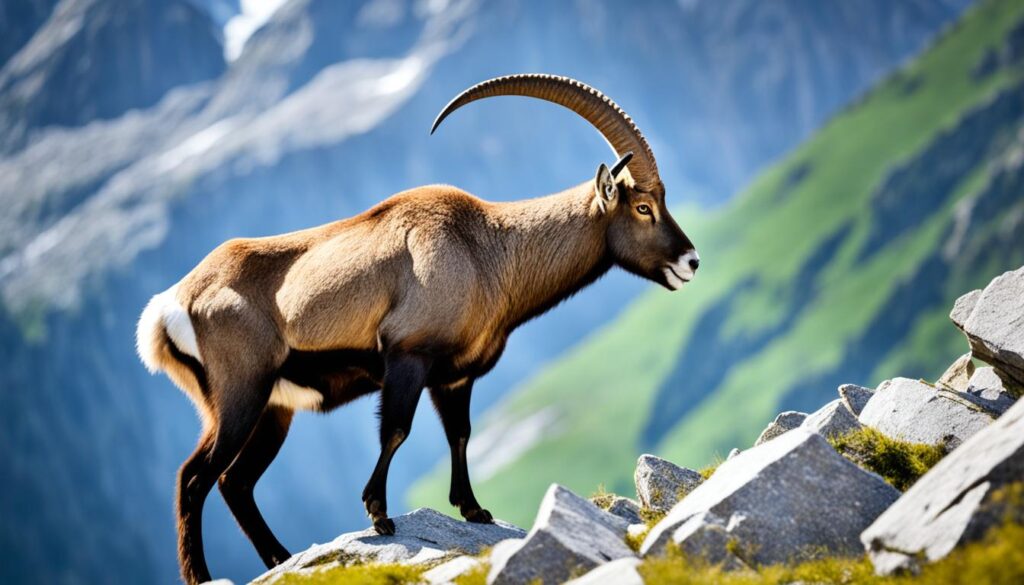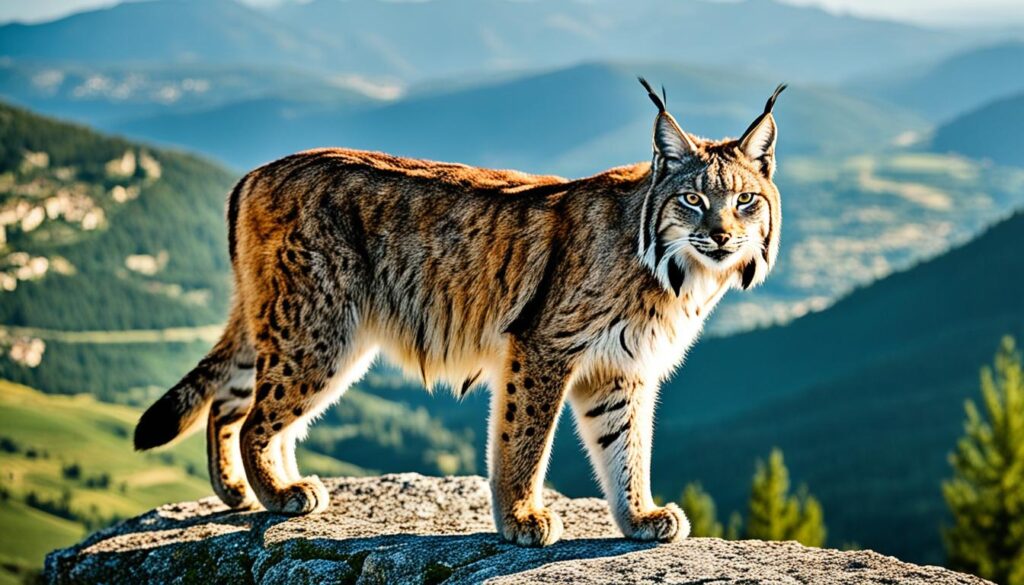Did you realize that Italy boasts an incredible variety of animal species? From the majestic wolves of the Apennines to the rare Marsican brown bear, this stunning country provides a chance to discover a diverse array of wildlife unlike any other. Whether you’re a passionate nature lover or just intrigued by the fascinating creatures that call Italy home, prepare for an adventure that will lead you through varied landscapes and introduce you to a plethora of species.
Key Takeaways:
- Italy is home to a wide variety of animal species, making it a paradise for wildlife enthusiasts.
- The fauna of Italy is incredibly diverse, with over 57,000 recorded species.
- The country boasts a high number of endemic species, with thousands found exclusively in Italy.
- Italy’s rich biodiversity is shaped by its diverse geography and climate.
- The country has established numerous national parks to protect its natural heritage and promote wildlife conservation.
The Fauna of Italy
The fauna of Italy is incredibly diverse, with over 57,000 recorded species, representing more than a third of all European fauna. Italy’s geographical location and varied terrain contribute to its high biodiversity. The country’s unique shape, with the Italian peninsula acting as a corridor between central Europe and North Africa, allows for the migration of species, resulting in a rich variety of wildlife. Furthermore, Italy’s geological structure, including the majestic Alps and the beautiful Apennines, provides different habitats that support a wide range of animal species.
The fauna of Italy encompasses a vast array of creatures, from tiny insects to large mammals. The country’s fauna is characterized by its richness, endemism, and conservation efforts. Let’s explore some of the fascinating animal species that call Italy home.
Endemic Species of Italy
Italy boasts a remarkable array of animal species, including a significant number of endemic species. These unique animals can only be found within the borders of Italy, making them an integral part of the country’s exceptional biodiversity. With 4,777 recorded endemic species, Italy offers a haven for wildlife enthusiasts and nature lovers alike.
“Italy’s endemic species contribute to the country’s rich biodiversity and represent the unique natural heritage of the region.”
Endemic species are those that have evolved and adapted to specific environmental conditions within a particular geographic area. Italy’s diverse landscapes, from the rugged mountains of the Alps and the Apennines to the lush Mediterranean coastline, have provided a range of habitats for these specialized animals to thrive.
Among the remarkable endemic species found in Italy are:
- The Sardinian long-eared bat (Plecotus sardus), which inhabits the island of Sardinia and plays a crucial role in local ecosystems as a pollinator and insect controller.
- The Sardinian red deer (Cervus elaphus corsicanus), a subspecies of red deer found in Sardinia and Corsica, known for its impressive antlers and adaptability to mountainous environments.
- The spectacled salamander (Salamandrina terdigitata), a unique amphibian characterized by its striking markings, including bright yellow spots and lines, found primarily in central and southern Italy.
- The Italian wall lizard (Podarcis siculus), a reptile species found predominantly in Italy and Sicily, known for its vibrant colors and ability to withstand urban environments.
These are just a few examples of the many fascinating endemic species that call Italy home. Their presence highlights the country’s commitment to conserving and protecting its natural heritage.

| Endemic Species | Habitat | Location |
|---|---|---|
| Sardinian long-eared bat | Caves and forests | Sardinia |
| Sardinian red deer | Mountainous regions | Sardinia, Corsica |
| Spectacled salamander | Forests, wetlands | Central and southern Italy |
| Italian wall lizard | Urban and rural areas | Italy, Sicily |
Biodiversity in Italy
Italy boasts a remarkable level of biodiversity, making it one of the most biologically diverse countries in Europe. This rich diversity is a result of various factors, including Italy’s temperate climate, diverse habitats, and unique geographical location.
The temperate climate of Italy provides favorable conditions for a wide range of animal species to thrive. From the coastal regions in the south with their Mediterranean climate to the alpine zones in the north, different climatic zones create diverse ecological niches that support a variety of flora and fauna.
The country’s geographical location is another crucial factor contributing to its biodiversity. Italy acts as a bridge between central Europe and North Africa, allowing for the migration of species across continents. This geographical advantage has led to a fascinating mix of animal species with European and North African influences.
With its varied terrain and landscapes, Italy offers an array of habitats for different animal species to inhabit. From the rugged mountain ranges of the Alps and the Apennines to the lush wetlands and coastal areas, each region provides a unique environment that supports a diverse range of wildlife.
Let’s take a closer look at the biodiversity of Italy through the following table:
| Flora and Fauna | Number of Species |
|---|---|
| Animal Species | 57,000+ |
| Plant Species | Over 7,900 |
As seen in the table, Italy boasts over 57,000 animal species, representing more than a third of all European fauna. In addition, the country is home to over 7,900 plant species.
Italy’s commitment to preserving its natural heritage is evident in the establishment of over 24 national parks and protected areas. These conservation efforts play a vital role in safeguarding the habitats of various animal species and ensuring the long-term sustainability of their populations.
Next, we’ll delve into the unique wildlife and fascinating species found in some of Italy’s renowned national parks.

Geography and Climate of Italy
Italy’s diverse wildlife is deeply influenced by its unique geographical features and climate. The country’s long peninsula, extending into the Mediterranean Sea, combined with the presence of the Apennine Mountains, creates a varied topography that supports a wide range of natural habitats and ecosystems.
Stretching from the Alps in the north to the rugged hills of the south, Italy’s geography is characterized by contrasting landscapes. These geographical variations play a vital role in defining the distribution of flora and fauna throughout the country.
The Apennine Mountains, running north-south through the center of Italy, act as a natural barrier, influencing the country’s climate and creating distinct climatic zones. As a result, Italy experiences a range of climates, including Mediterranean, alpine, and coastal climates.
The diverse climate zones in Italy provide a multitude of natural habitats that support a rich biodiversity. From the snow-capped peaks of the Alps to the sun-drenched coastline of the Mediterranean, each region boasts its own unique flora and fauna.
Geographical Features of Italy
Italy’s geographical features are a key factor in shaping the country’s natural habitats and biodiversity. Let’s take a look at some of the prominent geographical features:
- Apennine Mountains: The Apennines, spanning approximately 750 miles, form the backbone of Italy. These mountains divide the country into eastern and western coastal regions and create diverse ecosystems along their slopes.
- Alps: The majestic Alps are located in the northern part of Italy, bordering several European countries. These towering mountains are renowned for their awe-inspiring landscapes and are home to a variety of alpine species.
- Mediterranean Sea: Italy’s long coastline along the Mediterranean Sea provides a haven for marine life and supports unique coastal ecosystems.
- Islands: Italy is also home to several prominent islands, such as Sicily and Sardinia, which boast their own distinct flora and fauna.

Climate Zones in Italy
Italy’s climate varies significantly due to its geographical diversity. This diversity gives rise to different climate zones, which influence the distribution of wildlife throughout the country. Here are the main climate zones in Italy:
| Climate Zone | Characteristics |
|---|---|
| Mediterranean Climate | A warm and dry climate, characterized by hot summers and mild winters. This climate zone is prevalent along the coastal areas, including regions like Tuscany, Sicily, and Puglia. |
| Alpine Climate | Found in the high-altitude regions of the Alps, this climate zone is characterized by cold temperatures, heavy snowfall, and short summers. It supports unique alpine ecosystems and species such as chamois and marmots. |
| Continental Climate | Primarily found in the northern regions of Italy, this climate zone experiences hot summers and cold winters. It provides a habitat for species adapted to fluctuating temperatures, including deer and various bird species. |
| Coastal Climate | Located along the Italian coastline, this climate zone experiences relatively mild temperatures throughout the year. It supports diverse coastal ecosystems and species such as sea turtles and waterfowl. |
The combination of Italy’s geographical features and varied climate zones creates a rich tapestry of natural habitats. From the snowy peaks of the Alps to the sun-soaked shores of the Mediterranean, Italy’s landscapes provide the perfect backdrop for its diverse wildlife to thrive.
National Parks in Italy
Italy is dedicated to the conservation of its natural heritage through the establishment of more than 24 national parks. These protected areas span over 1.5 million hectares, encompassing 15% of the country’s land. Not only do these national parks preserve Italy’s stunning landscapes, but they also play a vital role in safeguarding the diverse wildlife and promoting biodiversity.
Famous National Parks in Italy
Italy takes pride in its remarkable national parks, each offering unique experiences and opportunities to immerse oneself in nature’s wonders. Let’s explore three of the most renowned national parks in Italy.
| National Park | Location | Key Features |
|---|---|---|
| Gran Paradiso National Park | Northern Italy, between the Aosta Valley and Piedmont regions | Home to the majestic Alpine Ibex and a wide range of wildlife species, including wolves, ermines, and alpine chamois. The park also offers breathtaking views of the iconic Gran Paradiso Mountain. |
| Dolomiti Bellunesi National Park | Located in the Dolomite Mountain Range in northeastern Italy | Famous for its untouched natural areas and more than 1,300 plant species, Dolomiti Bellunesi National Park attracts outdoor enthusiasts seeking adventure through skiing, mountain climbing, hiking, and paragliding. |
| Abruzzo, Lazio, and Molise National Park | Spanning across the Abruzzo, Lazio, and Molise regions in central Italy | This park boasts diverse landscapes and provides a sanctuary for various wildlife, including the iconic Marsican brown bear. Visitors can engage in activities such as horse riding, trekking, cycling, and canoeing while exploring the park. |

These national parks offer a glimpse into Italy’s stunning natural beauty, providing opportunities for wildlife observation, hiking, and reconnecting with nature. By preserving these protected areas, Italy promotes wildlife conservation and ensures the sustainable management of its ecological resources.
Wildlife in Gran Paradiso National Park
Gran Paradiso National Park, Italy’s first national park, is a sanctuary for diverse wildlife. Nestled in the heart of the country, this magnificent park offers a haven for a wide variety of species, showcasing the breathtaking beauty of Italy’s natural heritage.

One of the most iconic wildlife species that call Gran Paradiso National Park home is the Alpine Ibex. These majestic mountain goats are known for their impressive horns and agile climbing abilities. Visitors to the park may have the unique opportunity to witness these graceful creatures effortlessly navigating the rugged terrain of the Alps.
In addition to the Alpine Ibex, Gran Paradiso National Park’s diverse ecosystem supports a range of other wildlife species. The park is home to the elusive ermine, a small carnivorous mammal known for its white winter coat. The picturesque alpine meadows and rocky slopes also provide ideal habitats for the agile alpine chamois.
The park’s territories are also shared by the magnificent wolves, which play a crucial role in maintaining the ecological balance. These apex predators contribute to the park’s biodiversity by regulating populations and ensuring the sustainability of the ecosystem.
Bird Watching and Butterfly Sightings
Gran Paradiso National Park is a paradise for bird enthusiasts. The park boasts an array of bird species, including the fascinating golden eagle, which soars through the skies with effortless grace. Visitors can witness the captivating sight of these majestic creatures in their natural habitat, engaged in their daily routines.
The park’s diverse flora and favorable environmental conditions also create the perfect conditions for a vibrant butterfly population. With over 500 species recorded, the park provides ample opportunities for butterfly enthusiasts to witness the delicate beauty of these colorful insects fluttering amidst the alpine meadows.
Wildlife in Gran Paradiso National Park
| Wildlife | Description |
|---|---|
| Alpine Ibex | Majestic mountain goats with impressive horns |
| Ermine | Small carnivorous mammals known for their white winter coat |
| Alpine Chamois | Agile mountain goats inhabiting alpine meadows and rocky slopes |
| Wolves | Apex predators contributing to the park’s biodiversity |
| Golden Eagle | Majestic birds of prey soaring through the skies |
| Various Butterfly Species | A diverse population of colorful butterflies fluttering in the alpine meadows |
Exploring Gran Paradiso National Park allows visitors to immerse themselves in the wonders of nature and witness the incredible diversity of wildlife that thrives in this protected sanctuary. Whether you’re an avid hiker, wildlife enthusiast, or simply a lover of the outdoors, a visit to this remarkable national park is an experience that will leave a lasting impression.
Wildlife in Dolomiti Bellunesi National Park
Dolomiti Bellunesi National Park, nestled in northeastern Italy, is renowned for its breathtaking Dolomite Mountain Range. The park boasts a stunning array of natural landscapes, making it a haven for outdoor enthusiasts and a sanctuary for wildlife. With over 1,300 plant species and untouched areas of wilderness, the park offers a truly immersive nature experience.
Visitors to Dolomiti Bellunesi National Park can indulge in a wide range of activities, from skiing and mountain climbing to hiking and paragliding. These adventure-filled pursuits provide opportunities to soak in the park’s remarkable beauty while also offering glimpses of the diverse wildlife that call this area home.
Untouched Natural Beauty
The Dolomite Mountain Range, with its rugged peaks and scenic valleys, serves as an awe-inspiring backdrop for the park. The unique geological formations and pristine alpine meadows create a thriving ecosystem that supports a wide range of flora and fauna.
As you explore the park’s trails and valleys, you may encounter some of the region’s iconic wildlife. Keep an eye out for ibex, chamois, and deer gracefully navigating the rocky terrain. The park is also a haven for birdwatchers, with various species of birds soaring through the skies, including the majestic golden eagle.
“Dolomiti Bellunesi National Park is a true gem, offering a harmonious blend of natural beauty and abundant wildlife. It provides a fantastic opportunity for wildlife enthusiasts to observe diverse species in their natural habitats.”
Unforgettable Wildlife Experiences
Wildlife watching in Dolomiti Bellunesi National Park is a popular activity that allows visitors to witness the wonders of the animal world up close. Imagine spotting a family of chamois gracefully scaling the rocky slopes or catching a glimpse of a majestic wolf as it roams the vast wilderness. These encounters provide unforgettable memories and a deep appreciation for the beauty of nature.

Preserving Nature’s Treasures
Dolomiti Bellunesi National Park is dedicated to preserving its natural treasures and protecting the delicate balance of its ecosystems. The park plays a crucial role in conservation efforts, ensuring the long-term survival of its diverse plant and animal species for future generations to appreciate.
| Species | Description |
|---|---|
| Alpine Ibex | A majestic mountain goat species known for its impressive curved horns. |
| Golden Eagle | A magnificent bird of prey with a wingspan of up to 7 feet, known for its powerful hunting abilities. |
| Chamois | A nimble and agile mountain goat species that thrives in the alpine meadows. |
| Wolf | An elusive and highly intelligent predator that roams the park’s wilderness. |
When visiting Dolomiti Bellunesi National Park, remember to respect the wildlife and their natural habitats. Follow the park’s guidelines and be mindful of the fragile ecosystems that contribute to the park’s unique biodiversity.
Immerse yourself in the wonders of Dolomiti Bellunesi National Park, where the captivating beauty of the Dolomite Mountain Range converges with the rich diversity of wildlife, creating an extraordinary experience for nature enthusiasts.
Wildlife in Abruzzo, Lazio, and Molise National Park
Abruzzo, Lazio, and Molise National Park, established in 1922, is a haven for diverse wildlife. The park spans three provinces, covering a vast area with varied landscapes that provide a thriving habitat for many fascinating species. Among the notable wildlife found in this park is the elusive Marsican brown bear, a protected species that calls these dense forests and rugged mountains home.

The Marsican brown bear, also known as the Apennine brown bear, is a subspecies of the brown bear native to Italy. It is one of the rarest bear species in the world, making spotting one an extraordinary experience for wildlife enthusiasts. With their distinctive brown fur and powerful build, these magnificent creatures roam the secluded corners of the park, adding to its allure and natural beauty.
In addition to the Marsican brown bear, Abruzzo, Lazio, and Molise National Park are home to other remarkable wildlife species. Wolves, one of the park’s iconic inhabitants, dwell in the dense forests and are often heard howling in the night. Ibex, with their majestic curved horns, can be seen gracefully navigating the rocky terrain. The park is also an abundant sanctuary for various bird species, creating an avian paradise for birdwatchers and nature lovers alike.
To fully immerse oneself in the wonders of Abruzzo, Lazio, and Molise National Park, visitors can partake in a range of outdoor activities. Horse riding through serene valleys, trekking along picturesque trails, cycling amidst breathtaking landscapes, or canoeing along pristine rivers are just a few ways to explore this captivating wilderness. Each adventure offers a unique opportunity to encounter the park’s magnificent wildlife up close and appreciate the harmony of nature.
Activities in Abruzzo, Lazio, and Molise National Park:
- Horse riding
- Trekking
- Cycling
- Canoeing
| Wildlife in Abruzzo, Lazio, and Molise National Park | Activities |
|---|---|
| Marsican brown bear | Horse riding |
| Wolves | Trekking |
| Ibex | Cycling |
| Bird species | Canoeing |
Elusive Wildlife in Italy
Italy is renowned for its elusive and rare wildlife, offering nature enthusiasts the opportunity to spot some fascinating creatures. From the rediscovered lynx and resident wolves to the protected Marsican brown bear, Italy’s diverse landscapes are home to unique and captivating species.
The Rediscovered Lynx

The lynx (Lynx lynx) had been thought to be extinct in Italy for almost a century until its rediscovery in 2000. With its distinctive tufted ears and beautiful spotted coat, the lynx is an elusive and highly coveted sighting for wildlife enthusiasts. This elusive feline prefers dense coniferous forests and remote mountainous regions.
Wolves in the Italian Mountains
Wolves (Canis lupus) have a storied history in Italy and can still be found in certain regions. Although their numbers are smaller compared to other European populations, the presence of wolves in the Italian mountains is a testament to the country’s commitment to wildlife conservation. These majestic creatures play a vital role in maintaining the ecological balance of their habitats.
The Protected Marsican Brown Bear
The Marsican brown bear (Ursus arctos marsicanus) is a rare and protected species that can be spotted in central Italy. With an estimated population of less than 50 individuals, encountering this elusive bear is a truly special experience. Protected areas within Italy, such as the Abruzzo, Lazio, and Molise National Park, offer a sanctuary for this remarkable creature.
Exploring Italy’s wild landscapes and national parks provides an immersive experience in nature, offering the chance to encounter these elusive and awe-inspiring animals.
Unique Animal Species in Italy
Italy is a treasure trove of biodiversity, housing unique animal species that cannot be found anywhere else in the world. Exploring the country’s diverse landscapes and protected areas provides the opportunity to encounter these extraordinary creatures up close. Two such remarkable species are the Corsican hare and the golden eagle.
The Corsican Hare
The Corsican hare, also known as the “Lepus corsicanus,” is an endemic species found exclusively in Italy. Renowned for its agility and remarkable speed, this hare inhabits various regions across Italy’s countryside. Its unique adaptation allows it to navigate rocky terrains and sprint at impressive speeds, ensuring its survival in the challenging Italian landscape.
Spotting a Corsican hare in the wild is a thrilling experience, as it offers a glimpse into the country’s exceptional biodiversity. Observing these elusive creatures darting through their natural habitat is a surreal encounter that leaves visitors in awe of Italy’s remarkable wildlife.
The Golden Eagle
The golden eagle, with its majestic presence and awe-inspiring size, captures the imagination of wildlife enthusiasts. Often considered a symbol of strength and power, this impressive bird of prey can be found soaring across the Italian skies.
Italy’s diverse topography, which includes majestic mountains and vast wilderness, provides ideal hunting grounds for the golden eagle. It preys upon small mammals and birds, displaying remarkable hunting skills as it soars through the air. Witnessing the golden eagle in action is a breathtaking experience that showcases the grace and power of this iconic bird.
“Spotting a Corsican hare in the wild is a thrilling experience, as it offers a glimpse into the country’s exceptional biodiversity.”
The Corsican hare and the golden eagle are just two examples of the unique animal species that make Italy a captivating destination for wildlife enthusiasts. Their presence highlights the incredible diversity found within Italy’s natural habitats. Whether in pursuit of the agile Corsican hare or the awe-inspiring golden eagle, encountering these rare and exceptional creatures is sure to elevate any wildlife adventure in Italy.

Wildlife Encounters in Italy
Italy offers incredible opportunities for wildlife sightings, allowing visitors to witness the natural behavior of fascinating animals. From marmots to wild boars, the country is teeming with diverse wildlife waiting to be discovered.

Marmots: Observing Underground Habitats
Marmots, part of the squirrel family, are delightful creatures that can be observed in their underground habitats. These adorable rodents create intricate burrows that serve as their homes, providing them with safety and protection from predators. If you’re lucky, you might even catch a glimpse of these playful creatures as they scurry about their daily activities.
Wild Boars: Spotting in the Countryside
Wild boars are abundant in Italy, particularly in the countryside. These robust and powerful animals have a distinctive appearance, with their bristly coats, long snouts, and formidable tusks. As you explore the picturesque landscapes of Italy, keep an eye out for these intriguing creatures roaming freely in their natural habitat.
“Italy’s countryside offers a remarkable opportunity to encounter wild boars, providing a thrilling experience for wildlife enthusiasts.”
Whether you’re on a guided wildlife tour or embarking on a self-guided adventure, wildlife encounters in Italy will leave you with unforgettable memories. Immerse yourself in the beauty of nature and marvel at the diverse wildlife that calls Italy home.
Nature Watching in Italy
Nature watching in Italy is a tranquil and immersive activity that allows visitors to connect with the country’s diverse wildlife. With its stunning landscapes and abundant biodiversity, Italy offers a perfect setting for wildlife observation and appreciation.
Whether you’re a seasoned nature enthusiast or simply looking for a peaceful escape, nature watching in Italy provides an opportunity to slow down and witness the wonders of the animal world. It allows you to engage your senses, observe the behavior of fascinating creatures, and gain a deeper understanding of their habitats.
One of the highlights of nature watching in Italy is the chance to encounter elusive species like the lynx, known for its stealth and mystery. These magnificent creatures can be observed in their natural habitat, offering a rare and awe-inspiring experience.

In addition to the elusive lynx, Italy is home to a variety of wildlife that can be observed during nature watching expeditions. From the graceful movements of deer and wild boars to the soaring flight of eagles and hawks, there is no shortage of captivating moments to be captured.
One of the tranquil activities of nature watching is observing the playful marmots. These adorable creatures can often be spotted in their underground burrows, going about their daily routines. The whistling sound they make is a delightful addition to the natural soundtrack.
“Nature always wears the colors of the spirit.” – Ralph Waldo Emerson
Whether you choose to explore the national parks or venture into the countryside, nature watching in Italy offers a serene escape from the hustle and bustle of daily life. It provides an opportunity to disconnect from technology, immerse yourself in the beauty of nature, and find inner peace.
Benefits of Nature Watching
Nature watching not only brings joy and tranquility but also offers several benefits for mental and physical well-being:
- Reduces stress and promotes relaxation
- Enhances mindfulness and presence in the moment
- Increases physical activity through outdoor exploration
- Boosts mood and emotional well-being
Tips for Nature Watching in Italy
To make the most out of your nature watching experience in Italy, consider the following tips:
- Do your research: Learn about the local wildlife and their habitats before your trip.
- Choose the right time: Different species are more active during specific seasons, so plan your visit accordingly.
- Respect wildlife and their habitats: Maintain a safe distance, avoid making loud noises, and never feed or disturb the animals.
- Bring appropriate gear: Carry binoculars, a camera, comfortable clothing, and sturdy footwear for optimal exploration.
Embarking on a nature watching adventure in Italy allows you to connect with the beauty of the natural world and gain a profound appreciation for the delicate balance of ecosystems. So, pack your bags, immerse yourself in the tranquility of nature, and embrace the captivating experiences that await you in Italy.
Conclusion
Italy is a wildlife enthusiast’s dream destination, offering a remarkable array of species and stunning natural landscapes. The country’s diverse ecosystems and rich biodiversity make it a haven for animal lovers and nature enthusiasts alike. From the majestic Apennine wolves to the elusive Corsican hare, Italy’s wildlife is as diverse as its picturesque landscapes.
The national parks in Italy play a crucial role in preserving and conserving the country’s animal diversity. These protected areas provide a safe haven for various species and contribute to their overall conservation. By visiting these national parks, visitors not only have the opportunity to witness Italy’s incredible wildlife up close but also actively support nature conservation efforts.
Whether you are a passionate wildlife researcher, an avid photographer, or simply someone who appreciates the beauty of animals, Italy offers an unforgettable wildlife experience. Immerse yourself in the breathtaking scenery, listen to the songs of birds, and marvel at the wonders of Italy’s animal kingdom. Discover the magic that lies within the national parks and witness firsthand the importance of nature conservation in preserving our planet’s incredible wildlife.










